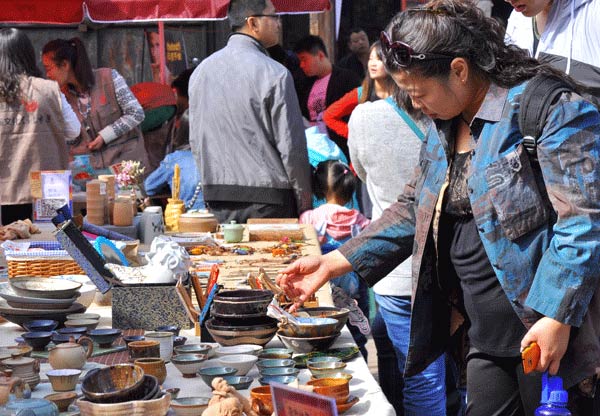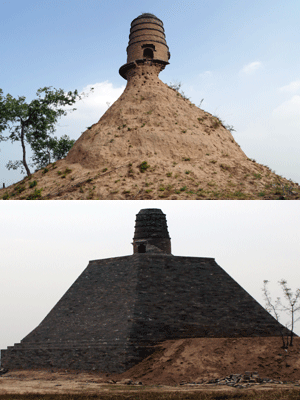Using the present to preserve the past
Updated: 2014-12-02 08:18
By Peng Yining(China Daily)
|
||||||||
Enthusiastic amateurs are using modern tools, such as social networks and digital publishing, to help save endangered cultural sites and forgotten art forms, as Peng Yining report.
When he first encountered the Wenfeng Pagoda, Tang Dahua could hardly believe his eyes. After hundreds of years of being scorched by the sun and battered by winds and rain, the 8-meter-diameter mound of mud supporting the five-story tower was so pitted and eroded that it resembled nothing so much as an enormous termites' nest with a 5-meter-high rotunda perched precariously atop it, looking as though it could come crashing to the ground at any moment.
The pagoda, built to provide beneficial feng shui for Qixian county in Shanxi province, can be traced back to the Ming Dynasty (1368-1644), but none of the locals could say how long it had been in its dilapidated condition. For them, it had always seemed on the point of collapse.
"When I first saw the pagoda in July, it was as if the wind could blow it down. There were piles of bricks and mud around it - the remains of previous ancient pagodas," said Tang, who spends his leisure time locating ancient architecture and trying to protect it. When the 44-year-old took a photo of the pagoda and posted it on Sina Weibo, a microblogging service with more than half a billion users, he wrote: "Probably the last sight of Wenfeng Pagoda in Jiancun village in Shanxi's Qixian county."
The unique shape of the endangered pagoda resulted in Tang's post being forwarded more than 2,000 times by netizens, who nicknamed the building Ta Jian Qiang, or "the tough tower".
The photo quickly became an Internet sensation across China - an online search for Ta Jian Qiang produces more than 577,000 pages, including a series of reports by the Xinhua News Agency - but it also became a symbol of the poor management of sites of historic interest. In August, a month after Tang's post, the Qixian government set about repairing the ancient building, a task that lasted until October.
Tang, an amateur historian who has traveled the length and breadth of China finding and protecting ancient architecture since 2006, admitted he had never seen a case like the pagoda, where the hits generated on social media attracted the attention of the local government and resulted in the building being repaired so quickly.
"If it weren't for the Internet and social networks, who would know or care about a collapsing tower in a remote village? I used to write letters to the local authorities when I discovered endangered architecture, but I never received any feedback. However, once it develops online, public opinion can prompt the authorities to take steps," Tang said. "Cultural heritage sites from China's long history are disappearing, but using the Internet, especially social networks, we can protect, and even renovate, them."
According to a 2011 archaeological survey, the last carried out in China, in the past three decades more than 40,000 immovable cultural relics have disappeared at an average of more than 1,000 every year.
Tang said Shanxi province has 280,000 sites of ancient architecture, more than any other province, and because Qixian county is famous for its large number of relic-rich resources, the Wenfeng Pagoda and several other endangered sites were in a long line of historic buildings awaiting repair.
"The bad news is they can't wait too long. They need greater attention and support, which is something we can generate on the Internet," he said. Since 2012, the number of people following his micro blog has grown from 100 to more than 10,000, and 16 of the 30 endangered sites he has posted have been repaired.
"Social networks bring these historic sites from the remote mountainous areas to center stage," he said. "It's all about attracting attention."
A colorful past
Wu Ziqi, 21, has spent the last year recording the history of his hometown, Zhanjiang in Guangdong province. The city has a colorful past, having been leased to France between 1899 and 1942, and occupied by Japan from 1943 until 1945, when its name was changed from Guangzhouwan, or Kwangchowan, to Zhanjiang.
Wu, a senior history major, said the city's colonial history is insignificant in terms of academic research, "but as a person who was born and raised in the city, I feel I have a responsibility to record the stories," he said.
Along with his team of about 10 volunteers, mostly students, Wu has interviewed more than 150 people who lived in Zhanjiang during the colonial years. The stories were posted online and so far they have attracted more than 1.9 million hits.
To continue the project, Wu started a fundraising campaign on WeChat, China's most popular messaging app, and about 3,000 people donated more than 18,000 yuan ($2,900) in just 24 days.
Wu said his research has unearthed a large number of previously unheard stories, including the origins of Pai Gu Fan, a famous local dish of boiled ribs with rice, which was once the staple breakfast for laborers.
"Even the smallest thing has a history worth recording," he said. "Without help from the public, those stories will die with the older generation."
Wu Ting, senior program manager for the charity platforms of Tencent Holdings Ltd, which owns WeChat, said the company is looking for more projects to help protect China's disappearing cultural heritage.
"Most endangered sites are unattended. They aren't popular, so they don't attract a lot of support. We don't expect to save them with a few big donations," she said. "Although the individual donations are small, the large number of people making donations online means that the total sum is considerable. The process of fundraising is also about education, and we want people to learn something about the city's history when they donate 10 or 20 yuan."
According to Wu Ting, most of the projects on the WeChat donation platform set targets of less than 1 million yuan - the sum is usually about 20,000 to 30,000 yuan - and the donations are worth less than 10 yuan on average. Since Tencent opened the platform to donors in October 2013, it has received almost 25 million donations worth a total of 238 million yuan.
One of the things Tencent has noticed is that most people donate via mobile devices, rather than computers.
Smartphone apps
"To fully utilize the social networks, we've developed a smartphone application about the history of 'Kwangchowan'," said Zhou Tengda, 28, director of the Kwangchowan History Research Group.
It took him a month to create the app, which contains more than 500 photos and stories adding up to about 500,000 Chinese characters. Instead of printing 5,000 books or pamphlets at a cost of about 25,000 yuan, Zhou opted to use the app, which cost less than 1,000 yuan.
"Digital publication is cheap, and it's also a good way of storing all the material," he said. "The younger generation is the one that will keep and pass on this heritage, so we need to present the content in a way they are familiar with and interested in."
By the end of the year, Zhou will unveil a website that will enable people nationwide to upload their family histories and communicate with each other to swap stories and other materials.
"I hope our research work in Zhanjiang can be expanded across the nation," he said. "Social networks connect people and that makes it easier for us to save our history together."
- Cultural identity of ancient town endangered by tourism
- 5,000 villagers face relocation to save endangered red-crowned cranes
- Film festival promotes endangered mountain communities
- Monastery creates unique bond with endangered bharal
- Fighting officials' long-entrenched social networks
- Work issues hijack social networks
- Social networks close gap across Taiwan Straits

 World AIDS Day marked around the world
World AIDS Day marked around the world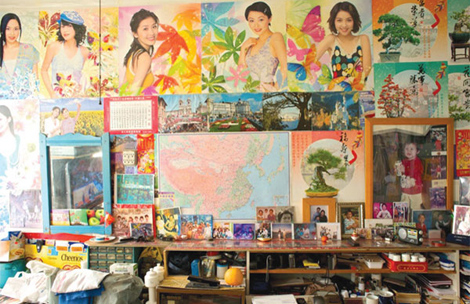
 Chinatown told through photos of peoples' rooms
Chinatown told through photos of peoples' rooms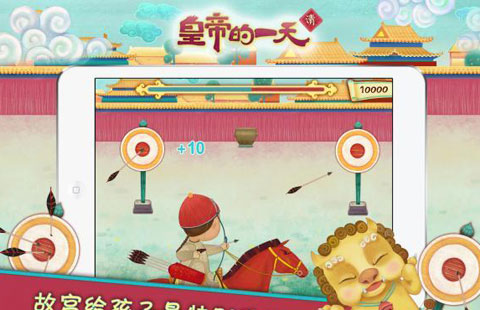
 Creative products by Palace Museum
Creative products by Palace Museum
 Group wedding before setting sail
Group wedding before setting sail
 Guangzhou zoo is home to five generations of koalas
Guangzhou zoo is home to five generations of koalas
 Top 10 favorite gift brands of rich Chinese men
Top 10 favorite gift brands of rich Chinese men
 UN climate change conference kicks off in Lima
UN climate change conference kicks off in Lima
 8 luxury cars and the image of their owners
8 luxury cars and the image of their owners
Most Viewed
Editor's Picks
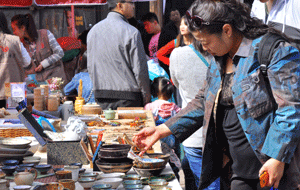
|

|

|

|

|

|
Today's Top News
Using the present to preserve the past
Chinese investors helping build major US road link
Chinatown told through photos of peoples' rooms
Online sales boost Black Friday
More and more shoppers are going mobile
Chinese culture inspiration for student
Lima climate summit begins 2-week parlay
Tolerance ends, HK chief vows
US Weekly

|

|
